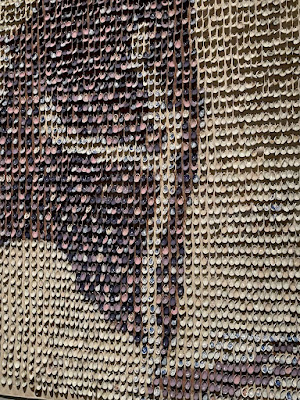
demonstrating that religion was an idiom in which ideals were articulated, communities conceived, landscapes claimed, biases challenged and a national culture forged. Yet despite the best efforts to replace "manifest destiny" with new stories, the overall exhibition can't but reproduce its shape: a story which moves westward, bringing otherwise unknown lands into history. But the land wasn't waiting to be discovered...
 What might really upend the narrative? After our tour and some discussion, some students and I explored "The Collection: New Conversations" upstairs, which brilliantly dislodges all sorts of received views and images with remarkable newer works. A case in point which left us stammering with admiration and delight was Shinnecock ceramicist Courtney M. Leonard's "Contact, 2,021" (2021), composed of 3500 porcelain shells bearing the artist's fingerprint, in colors evoking both the purple and white quahog shells used to make wampum, shell-adorned deerskins worn by her Shinneckock ancestors, and the map of the Empire State.
What might really upend the narrative? After our tour and some discussion, some students and I explored "The Collection: New Conversations" upstairs, which brilliantly dislodges all sorts of received views and images with remarkable newer works. A case in point which left us stammering with admiration and delight was Shinnecock ceramicist Courtney M. Leonard's "Contact, 2,021" (2021), composed of 3500 porcelain shells bearing the artist's fingerprint, in colors evoking both the purple and white quahog shells used to make wampum, shell-adorned deerskins worn by her Shinneckock ancestors, and the map of the Empire State. On closer approach, many of these porcelain shells, including all those along the shores of Long Island and the length of the Hudson River,
prove to be individually painted, evoking now seashell patterns, shards of Dutch porcelain and old engravings or photographs.
Enraptured, we could have spent all afternoon in this work. Might something like this have reminded the viewers of "Acts of Faith" that Turtle Island had a history and spiritual significance before its de- and desacralization by those venturing westward voluntarily and involuntarily (displaced Indians, enslaved Africans, persecuted Mormons all have their moment in the exhibition), that these movements aren't the first in this divine land - or the last?


